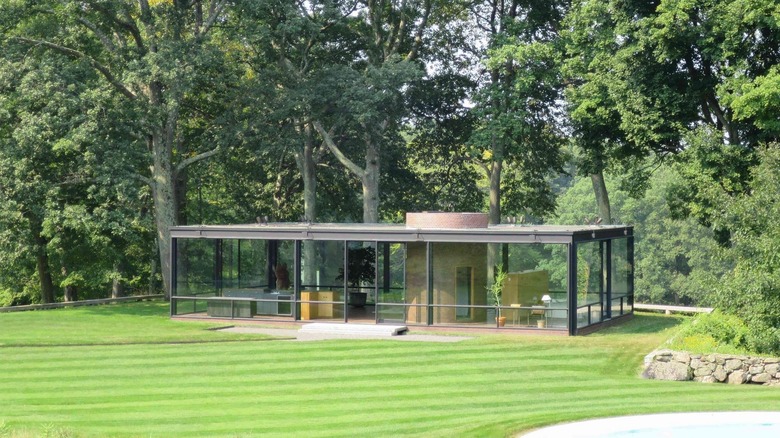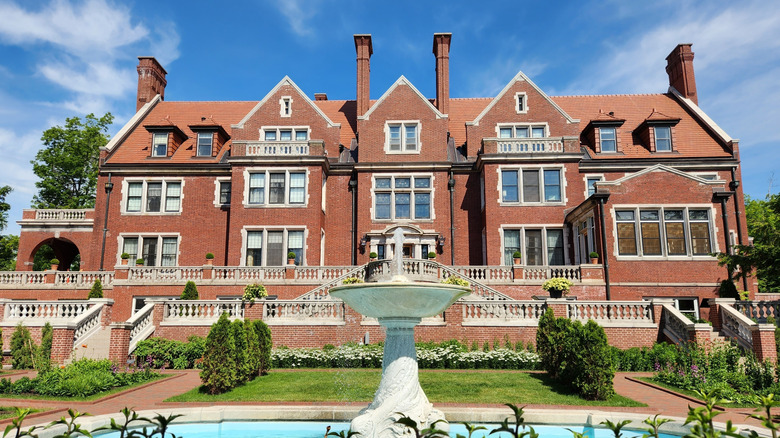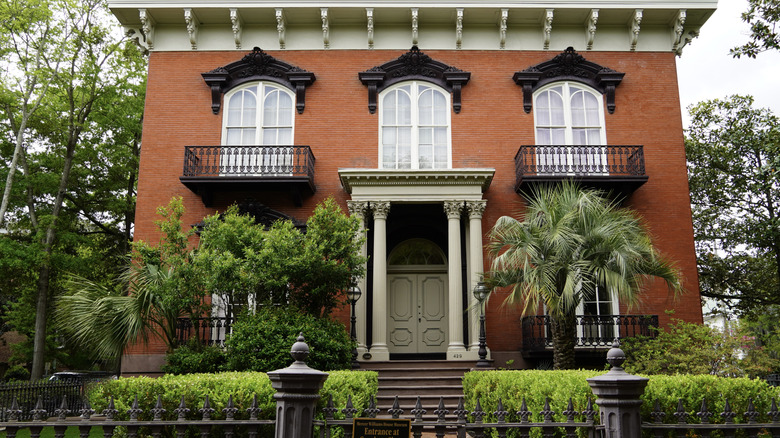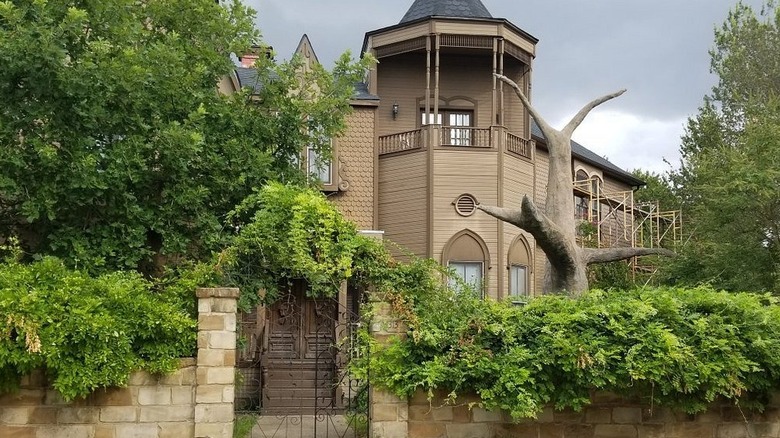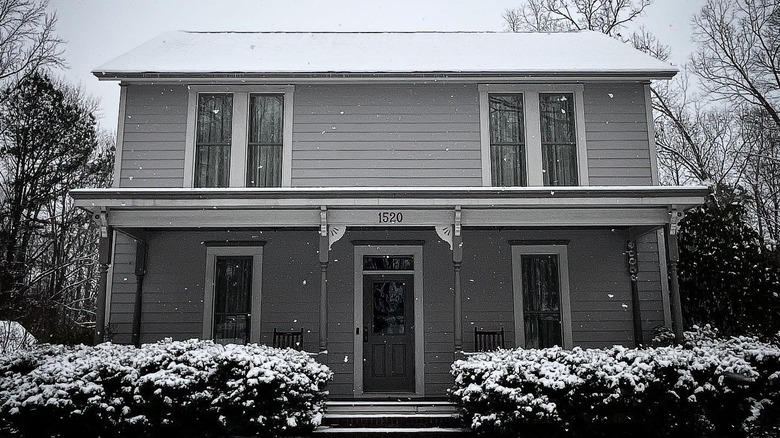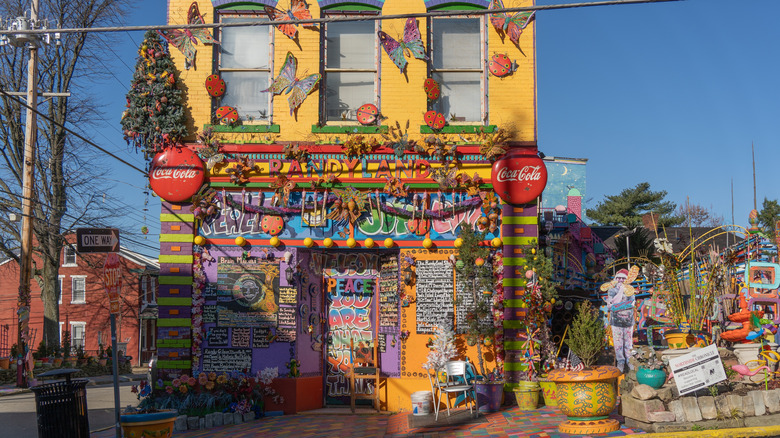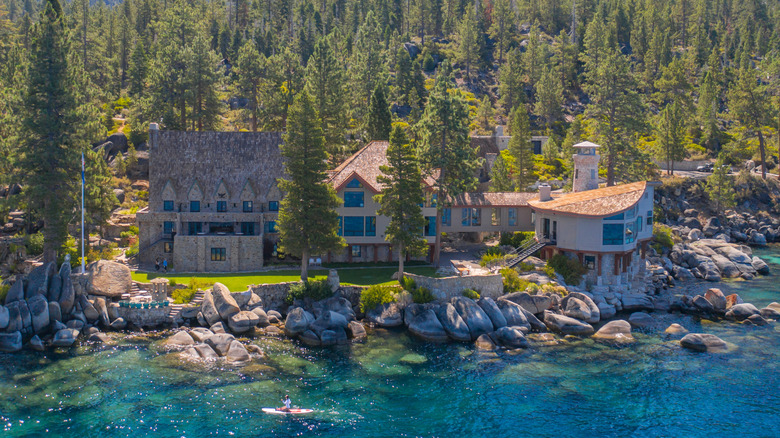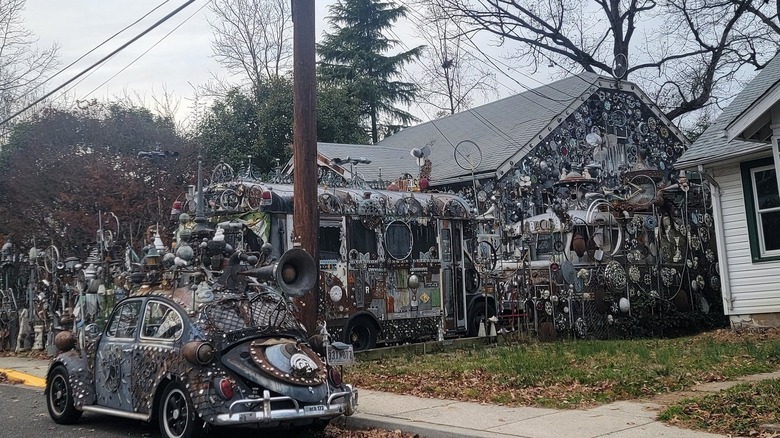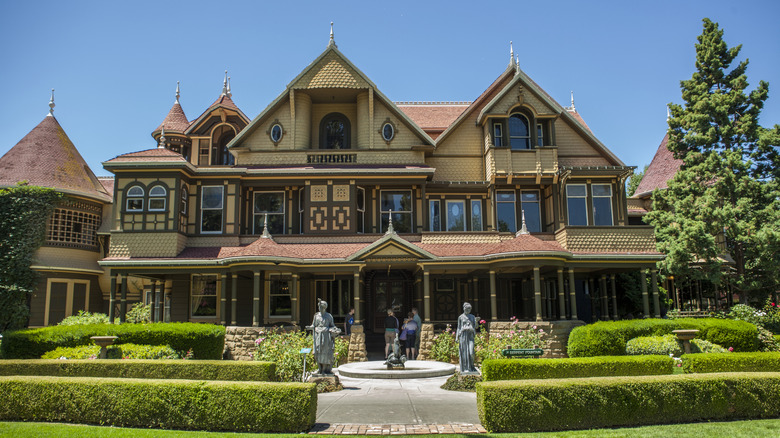America's Most Quirky Homes That Offer Unique Tours To Tourists
Unless you're an architect or design buff, you've probably snored through a house tour that's a so-called tourist attraction. We've been bored during a description of an architectural style, yawned at a history lesson, pretended to be interested in original floors, and tried our best not to touch anything and get in trouble. But on these U.S. home tours, you won't need your travel buddy to remind you to stop rolling your eyes. The same applies to these quirky houses around the world that should be on your bucket list.
These homes are seriously cool, ranging from the recreation of serial killer Michael Myers' house in the movie "Halloween" to a bizarre structure that houses a sea monster and the biggest miniature doll house collection on Earth. They'll have you doubting your recent run-of-the-mill home renovation in no time. Best of all, they're open to the public. For ticket prices starting at just $3, you can tour these homes and see America's weirdest architecture up close. But don't wait; many of their tickets sell out early, and space is limited.
The Glass House in New Canaan, Connecticut
Artwork isn't needed to spruce up the The Glass House in New Canaan, Connecticut. With completely see-through walls, the house has a perfect view of the surrounding 49 lush acres. The property also contains 14 other creativity hotspots throughout the acreage, like the Painting Gallery and Sculpture Gallery. They're all owned by the National Trust for Historic Preservation. The galleries contain acclaimed artworks and ever-changing exhibits.
Philip Johnson built The Glass House between 1949 and 1995 after the Farnsworth House inspired him. At the time, the Glass House was a groundbreaking rarity. It also helped integrate architectural styles from all over the world into U.S. homes. But it wasn't just a statement — it was an actual home. Johnson lived there with his partner, David Whitney, who also worked in the art world.
Adults and kids over 10 can visit the Glass House seasonally for a wide array of tours. A one-hour tour is $25 to $30, and a two-hour tour of the house and galleries is $50 to $60. For an hour-and-a-half tour of the entire property, you will pay $85 to $100, but a three-hour self-guided tour costs $50.
Glensheen Mansion in Duluth, Minnesota
A visit to the Jacobean-style Glensheen Mansion on Lake Superior in Duluth, Minnesota, is a step back in time. It still contains a top hat in the closet, letters in a desk drawer, and sheets in a linen closet, just as they were more than a century ago when the Congdon family built the home. The Congdons, who grew their fortune from iron mining, built the 27,000-square-foot home between 1905 and 1908 for their family of eight. It cost $854,000, which would be more than $30 million today.
Glensheen Mansion has 39 rooms; it's nestled on 12 acres and comprises gardens, foliage, and bridges. It even has a vegetable garden, tennis courts, pool, boat house, greenhouse, orchard, barn, and reservoir. With so much beauty inside and out, it's unsurprising that the Glensheen Mansion is the most-visited historical house in the state. However, the home has a dark history behind its beauty. One of the adopted Congdon children, Marjorie Congdon, unsuccessfully attempted to kill her mother at the mansion to expedite a $8-plus million inheritance. She then later facilitated the murder of her sister, also at the mansion.
Several tour options are available — generally, the $20 self-guided classic tour is recommended for first-timers and families. An audio tour takes visitors through three floors of the home for over one hour. For a more in-depth experience, book the $32 hour-and-a-half self-guided full mansion tour, which showcases all five floors of Glensheen Mansion to visitors.
Hearst Castle in San Simeon, California
It's hard to imagine the magical Hearst Castle being anything but William Randolph Hearst's San Simeon, California, estate. But prior to 1919, it was a nearly 38,000-acre plot of land owned by his parents. When they passed away, Hearst, a newspaper magnate, added more than 200,000 acres to the property. He then worked with architect Julia Morgan to create what became La Cuesta Encantada, otherwise known as The Enchanted Hill. It contains a main structure with two towers called Casa Grande, three guest houses, gardens, fountains, pools, and more. It even has a Gothic-style study with a 14th-century Spanish ceiling where Hearst previewed his newspapers every evening.
The best tour for newcomers is the one-hour Grand Rooms Tour, which showcases the five feature rooms of the home — the Assembly Room, Refectory, Morning Room, Billiard Room, and Theater. Those who want to see how Hearst lived personally should opt for the one-hour Upstairs Suites Tour, which brings visitors through his study, Celestial Suite, library, Della Robbia Room, and Duplex Suite. Or, see Hearst's art collection in the two-hour Art of San Simeon Tour, which presents his paintings, tapestries, sculptures, and antiques. If you're an architecture fan, then check out the Julia Morgan Tour, which features Morgan's work on Hearst Castle. As California's first female architect, she oversaw every inch of the creation of the castle. This tour also presents information about her life and talent, as well as her architectural drawings.
House on the Rock in Spring Green, Wisconsin
Don't let the simple name of this attraction in Spring Green, Wisconsin, fool you. House on the Rock is built on a chimney of rock — a stunning geological formation that sees a rock rise higher than its surroundings. The house contains everything from the biggest carousel in the world to a 218-foot-long room made of 3,000 pieces of glass. It's also one of the tourist traps in America that are actually worth visiting. Interestingly, it has not been completed yet! The building began in 1945 by Alex Jordan, who wanted to create a home that paid homage to the stunning surrounding views. But what resulted was much more than a lookout point.
Just a few of the unique elements in the museum-like home include three of the largest organ consoles on the planet, one of the most extensive miniature dollhouse collections, and a 200-foot-tall sea monster. It also has a stroll Japanese garden, a model of a street from the 19th century, and a massive collection of circus displays. Furthermore, House on the Rock has 6,000 Santa figurines and endless oddities.
People can book self-guided tours of different elements of the house for $20 to $37 per adult and $12 to $20 per child. Prices require an additional 5.5% Wisconsin sales tax. Since there's so much to see — especially if you book the three-and-a-half-hour Ultimate Experience tour — the House on the Rock has its own resort to offer respite to tired guests. Besides offering proximity to this Midwestern destination home, the resort also has a 27-hole golf course, a spa, and 80 suites.
Mercer Williams House Museum in Savannah, Georgia
If you take a tour of the Mercer Williams House in Savannah, Georgia, you'll be enamored by the home's brick façade, Renaissance Revival architecture, and Southern charm. It was created for General Hugh Weedon Mercer, although he never lived there due to construction delays caused by the Civil War. After that, the Shriners Alee Temple was housed here before the structure fell vacant for a decade. Then, antiques salesman and home restorationist Jim Williams bought it in 1969. On the 35-minute, $13.50 tour, you'll see his furniture, Chinese porcelain, and the home's original touches. But since Williams' sister owns and runs Mercer Williams House, you won't hear what makes this building so infamous in the first place.
As the setting of the famous book "Midnight in the Garden of Good and Evil," the Mercer Williams House is the most haunted home in Savannah. Danny Hansford, Williams' assistant and alleged boyfriend, was shot and killed in the home in 1981. Williams controversially went to trial for the murder four times but was ultimately found not guilty. However, his fortune ended there. Just half a year after the end of the last trial, Williams died of heart failure after a bout of pneumonia. It happened steps away from where Hansford was killed in the Mercer Williams House. Today, it's purported that Hansford's ghost continues to haunt the home, and many visitors have claimed to have had paranormal experiences there.
Munster Mansion in Waxahachie, Texas
The classic 1960s sitcom, "The Munsters," is still a household name. However, you don't need to settle for experiencing it from a television screen, thanks to the Gothic-style Munster Mansion in Waxahachie, Texas. A 5,800-square-foot recreation of the home where characters Herman, Lily, Eddie, Grandpa, and Marilyn Munster lived, the home offers a life-sized blast from the past for "The Munsters" fans. The structure, complete with chandeliers swarmed with cobwebs and items from the show, was designed by Sandra and Charles McKee and is their residence. It's home to one of the biggest collections of "The Munsters" memorabilia on the planet. It's also everchanging, as the McKee's have continued to perfect it since 2002 by watching "The Munsters" episodes — with no blueprints from the TV show in sight.
Expect to see vintage phones and clocks, a grand staircase, creepy portraits, and throwback furniture. Fans of the "The Munsters" can book private tours of the house for $120 per four-person group. Or, see the house and get a meal at one of the Munster Mansion's monthly murder mystery dinners. The intimate dinners, which seat just 10 people, offer tours of the mansion as well as an interactive murder mystery experience for $125 per person. Periodically, the Munster Mansion also hosts meet-and-greets with the actors who played the beloved characters.
Myers House in Hillsborough, North Carolina
It's always Halloween at the Myers House in Hillsborough, North Carolina. A model of killer Michael Myers' house from the movie "Halloween," the Myers house is the creation and home of Kenny Caperton. As a kid, his favorite movie was "Halloween." So, when it came time to buy his first home, Caperton decided to recreate what was on his screen the most. After a year and a half of work, his dream came to fruition in 2009. He was finally living in a replica of the "Halloween" movie set in South Pasadena, California. Caperton's home is decked with 80s movie memorabilia like props, masks, vintage televisions, jukeboxes, and more. The Myers House has become famous in its own right. It's been featured in a slew of media outlets, including Yahoo!, CNN, Fox News, CNBC, and the Biography Channel.
People can see the exterior of the home on a 30-minute tour that offers Halloween candy, a history of the home's building and original set, and a photo opportunity. Tours are hosted on one Saturday per month for a $3 minimum donation. Don't forget to wear your Michael Myers mask. The only exterior difference you'll notice from the movie is that the North Carolina counterpart is located on 5 acres of countryside rather than in a suburban neighborhood. To see the inside of the home, mark your calendar for its annual Halloween party.
The Paper House in Rockport, Massachusetts
Newspapers might be halfway out the door, but the Paper House in Rockport, Massachusetts, has long put them to good use. The wood-framed house was built in 1922 as a summer home by Elis Stenman, a mechanical engineer and Cambridge resident. But when it came to the walls and insulation of his new escape, Stenman, a Swedish immigrant, decided to get creative.
As the subscriber of three daily newspapers, Stenman rolled them up after reading and glued them down to create ½-inch paper walls. He even used the papers to create a table, chairs, bookshelf, curtains, fireplace, and grandfather clock made with papers from the capital cities of each U.S. state. The home had running water and electricity, although its bathroom was outside in an outhouse. Today, visitors can still see the paper walls' headlines, like the one proclaiming "LINDBERGH HOPS OFF FOR OCEAN FLIGHT TO PARIS."
No one is sure why Stenman decided to insulate his home with 100,000 newspapers, but it's thought that timing played a part. The Great Depression was from 1929 to 1941, and times were tough while Stenman was building his home. Stenman was an engineer and curious to see how hardy the paper was — especially during the infamously cold and snowy Massachusetts winters. Clearly, his experiment proved correct. Today, people can visit the home seasonally for a self-guided tour for a $2 donation.
Randyland in Pittsburgh, Pennsylvania
Randy Gilson was once homeless, but these days, he's more than made up for it with a whimsical, colorful house called Randyland that makes everyone feel welcome. With just $10,000 on a credit card, he purchased a house in 1995 in the then-run-down North Side neighborhood in Pittsburgh, Pennsylvania. Although he knew nothing about art, he transformed it into an art studio, museum, sustainability statement, and a home all in one. It has even earned the Mayor's Award for Public Art and is considered one of the unexpected museums in this unique Pennsylvania city. Discarded items like mannequins and pink flamingoes are intermixed with wild murals and one-of-a-kind pieces, which can all be seen with a $49 ticket.
There is always a reason to return to Randyland — its collection is still growing, and many art pieces are available for you to see. A few of the standout pieces include a 40-foot mural of various creatures in their natural habitats, sewer pipes transformed into planters, and lawn chairs suspended from a fire escape. It's all painted in 50 bright, feel-good colors.
Thunderbird Lodge on Lake Tahoe, Nevada
With a cost of living nearly 24% higher than the national average, Lake Tahoe, Nevada, is not a budget-friendly destination. However, millionaire businessman and San Francisco resident George Whittell took that to the next level when he decided to build a colossal estate there in 1936. Although he originally planned to use the property and adjacent acreage to construct homes, a hotel, a casino, and a ski resort, he created a natural escape instead.
Named in honor of the mythical bird sacred to Indigenous people, Whittell named his summer home the Thunderbird Lodge. He worked with architect Frederic DeLongchamps, who designed the Nevada State Capitol and the El Cortez Hotel and Casino. Their collaboration birthed an architectural marvel, which comprises nods to the architectural styles of Indigenous people. Whittell's home was a celebration of the surrounding landscape and an exhibition of his enormous wealth. It held a boathouse accessible by a 600-foot tunnel, his massive international art collection, and animals like elephants, lions, and bears. He also hosted parties frequently at Thunderbird Lodge and invited prominent guests.
Thunderbird Lodge's future was uncertain after Whittell died in 1969, and a new developer hoped to transform the property into a resort. Thanks to action by locals and conservationists, it was saved and added to the National Register of Historic Places. Now owned by the nonprofit Thunderbird Lodge Preservation Society, it can be visited on guided, hour-and-a-half tours for $75 per person.
Vanadu Art House in Hyattsville, Maryland
Take a look at any suburban modern house today, and you can bet you'll see a gray box with minimalist décor and neutral tones. But to Clarke Bedford, that couldn't be more boring. That's why his home in Hyattsville, Maryland, is completely decked out with unique antiques, recycled materials, and historical items for the ultimate maximalist style.
Vanadu Art House features everything from a statue of John Locke to four cars also made of similarly odd materials. It all follows a steampunk and Victorian style. Bedford's most well-known vehicle has graveyard spires on the roof and vases and horns on the sides. The collecting nature comes naturally to Bedford, a retired Smithsonian art conservator. He used his skills to securely install each item to prevent natural elements from damaging them.
Despite the full look of the property, Bedford is always installing new pieces at the Vanadu Art House. It's a fitting name for the home, as it's inspired by Xanadu, Kubla Khan's fabled fortress, and Charles Foster Kane's estate in "Citizen Kane." Bedford began the never-ending project on his circa-1918 home in 2005. Although visitors can't go inside without Bedford's permission, they're welcome to admire his work from the sidewalk. Plus, there's a good chance you'll see him tinkering with his living artwork outside anyway.
Winchester Mystery House in San Jose, California
If you think your home renovation is running long, then you haven't visited the Winchester Mystery House in San Jose, California. For 36 years, Sarah Lockwood Pardee, a Winchester Repeating Arms heiress, continuously expanded her originally eight-room farmhouse until she died. For the 24,000-square-foot house with 160 rooms, she spent $5 million, which is $71 million today. However, creating a more attractive home wasn't her only intention. To build continuously, the Winchester Mystery House has doors that lead to drops, stairs that lead to ceilings, and secret passageways. Today, the question remains: Why did Pardee continue to expand her home? You might discover why if you get lost in the bizarre history of the Winchester Mystery House.
According to legend, Pardee was haunted by the ghosts of the people killed by Winchester weapons. A psychic instructed her to keep building her home to prevent the ghosts from terrorizing her. Another legend states that the massive size of the house allowed Pardee to hide from the apparitions. These myths make the Winchester Mystery House one of the most haunted places in America. Visitors can see 110 of the house's rooms on guided, hour-long tours that cost $46 to $49 per person. Those interested in the more paranormal aspects of the mansion can see the basement, where tons of ghostly activity has allegedly taken place, at an additional cost.

